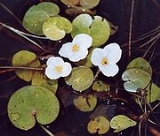
Hydrocharis morsus-ranae
Encyclopedia
Hydrocharis morsus-ranae, Frogbit, is a flowering plant
belonging to the genus Hydrocharis
in the family Hydrocharitaceae
. In North America, it is referred to as Common Frogbit or European Frogbit to distinguish it from the related American Frogbit (Limnobium spongia).
It is a small floating plant resembling a small water lily
. It bears small, three-petalled white flower
s. The floating leaves are kidney-shaped and grow in rosettes on the water surface, with the roots hanging down into the water column but not normally touching bottom. Frogbit is fast growing and spreads rapidly by stolon
s, surviving the winter as dormant turions which rest on the bottom, rising again to the surface in spring.
Frogbit is native to Europe
and parts of Asia
, but it was introduced to Canada
in the 1930s and has become invasive
in eastern Canada and the northeastern USA, particularly around the Great Lakes
. It is considered a pest in this region as it colonises waterways and forms dense masses of vegetation on the surface, threatening native biodiversity
, although in its native areas it is rarely dominant
.
Flowering plant
The flowering plants , also known as Angiospermae or Magnoliophyta, are the most diverse group of land plants. Angiosperms are seed-producing plants like the gymnosperms and can be distinguished from the gymnosperms by a series of synapomorphies...
belonging to the genus Hydrocharis
Hydrocharis
Hydrocharis is a genus of aquatic plants within the family Hydrocharitaceae.The best known species is Hydrocharis morsus-ranae, commonly called common or European frogbit, and occasionally water-poppy. The name "American frogbit" refers to another aquatic plant, Limnobium spongia....
in the family Hydrocharitaceae
Hydrocharitaceae
Hydrocharitaceae is a flowering plant family that includes a number of species of aquatic plant, broadly called the Tape-grasses, and includes the well known Canadian Waterweed and Frog's Bit.The family includes both fresh and marine aquatics...
. In North America, it is referred to as Common Frogbit or European Frogbit to distinguish it from the related American Frogbit (Limnobium spongia).
It is a small floating plant resembling a small water lily
Nymphaeaceae
Nymphaeaceae is a family of flowering plants. Members of this family are commonly called water lilies and live in freshwater areas in temperate and tropical climates around the world. The family contains eight genera. There are about 70 species of water lilies around the world. The genus...
. It bears small, three-petalled white flower
Flower
A flower, sometimes known as a bloom or blossom, is the reproductive structure found in flowering plants . The biological function of a flower is to effect reproduction, usually by providing a mechanism for the union of sperm with eggs...
s. The floating leaves are kidney-shaped and grow in rosettes on the water surface, with the roots hanging down into the water column but not normally touching bottom. Frogbit is fast growing and spreads rapidly by stolon
Stolon
In biology, stolons are horizontal connections between organisms. They may be part of the organism, or of its skeleton; typically, animal stolons are external skeletons.-In botany:...
s, surviving the winter as dormant turions which rest on the bottom, rising again to the surface in spring.
Frogbit is native to Europe
Europe
Europe is, by convention, one of the world's seven continents. Comprising the westernmost peninsula of Eurasia, Europe is generally 'divided' from Asia to its east by the watershed divides of the Ural and Caucasus Mountains, the Ural River, the Caspian and Black Seas, and the waterways connecting...
and parts of Asia
Asia
Asia is the world's largest and most populous continent, located primarily in the eastern and northern hemispheres. It covers 8.7% of the Earth's total surface area and with approximately 3.879 billion people, it hosts 60% of the world's current human population...
, but it was introduced to Canada
Canada
Canada is a North American country consisting of ten provinces and three territories. Located in the northern part of the continent, it extends from the Atlantic Ocean in the east to the Pacific Ocean in the west, and northward into the Arctic Ocean...
in the 1930s and has become invasive
Invasive species
"Invasive species", or invasive exotics, is a nomenclature term and categorization phrase used for flora and fauna, and for specific restoration-preservation processes in native habitats, with several definitions....
in eastern Canada and the northeastern USA, particularly around the Great Lakes
Great Lakes
The Great Lakes are a collection of freshwater lakes located in northeastern North America, on the Canada – United States border. Consisting of Lakes Superior, Michigan, Huron, Erie, and Ontario, they form the largest group of freshwater lakes on Earth by total surface, coming in second by volume...
. It is considered a pest in this region as it colonises waterways and forms dense masses of vegetation on the surface, threatening native biodiversity
Biodiversity
Biodiversity is the degree of variation of life forms within a given ecosystem, biome, or an entire planet. Biodiversity is a measure of the health of ecosystems. Biodiversity is in part a function of climate. In terrestrial habitats, tropical regions are typically rich whereas polar regions...
, although in its native areas it is rarely dominant
Dominance (ecology)
Ecological dominance is the degree to which a species is more numerous than its competitors in an ecological community, or makes up more of the biomass...
.

